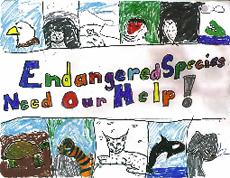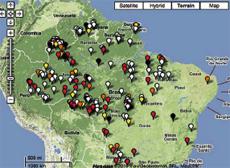At first glance, the following items may seem to have nothing in common: an Amur leopard, a Brazil-nut Tree, 510th Fifth Avenue, Bolivia’s Carnival of Oruro, the Tofa language from Irkutsk, a Usambara Blue-bellied frog, a Masoala madagascariensis, Nasca lines and geoglyphs in Peru, Viennese coffee house culture, and Cameroon’s Ndai language. Nonetheless, they all belong together, and not just because, as with Jorge Luis Borges’ Celestial Emporium of Benevolent Knowledge, a category can be made to arbitrarily encompass them. All the items—animal and plant species, sites and buildings, cultural practices, and languages—have been categorized as endangered. While such categorizations are often subject to debate, endangerment tends to be taken for granted both as a concept and a phenomenon. A Working Group at the Max Planck Institute for the History of Science seeks to challenge the taken-for-granted nature of endangerment in contemporary discourse by placing it in conceptual and historical perspectives and exploring the situated, culturally and historically specific character of the imperative to preserve nature and culture.

Fig. 2: From the announcement of the USA national Endangered Species Day Art contest, 2010.
The International Union for Conservation of Nature has been inventorying species in danger of becoming extinct since 1963; in more recent decades, foundations and international organizations have made it their mission to identify various forms of threatened cultural heritage, both tangible like buildings and “intangible,” like artistic expressions and traditional systems of knowledge. In all cases, qualifying something as endangered is a necessary step towards the ultimate goal of protecting and preserving it.
The notion of endangerment stands at the heart of a network of concepts, values and practices dealing with entities considered threatened by extinction or destruction, as well as with the procedures aimed at gathering data about them, and preserving them as far as possible. The perception of endangerment drives the constitution of documentary devices, such as archives, catalogues, databases and atlases, which embody different forms of knowledge, but share a memorializing urge. Often animated by a sense of urgency and citizenship, identifying and cataloguing endangered entities involves evaluating the intensity of the impending threat and opens the way for preservation strategies. Both evaluation and preservation, however, often imply conflicts of interest and interpretation. For example, the politics of whaling are riddled by scientific uncertainty over population estimates, the effects of environmental change, maximum sustainable yield levels, and the monitoring of catches. Disputes about uncertainty itself play an essential role in negotiations among scientists, conservationists, traditional hunters, and the whaling industry; and it is these negotiations that shape policy and, return, contribute to shape science. By focusing on endangerment—with its suffix signifying the action of putting something in danger—the Working Group Endangerment and Its Consequences seeks to examine the construction of data deemed significant, the kind of knowledge such data constitutes, the epistemic and institutional structures into which it is organized, the affects that permeate it, and the moral and epistemic values it incarnates.
Perceiving and labeling something as endangered has a number of consequences. To begin with, endangerment is coupled with value in a kind of looping effect. We protect things we cherish; in turn, things become more cherishable when they seem to be threatened, and especially valuable after they’ve received the official label and effort has been expended to save them. Thus, at the beginning of the United States Endangered Species Act, the organisms to be protected are declared to be “of esthetic, ecological, educational, historical, recreational, and scientific value to the Nation and its people.” There is sometimes debate about what exactly makes those organisms so precious, but the endangered tag certifies that they are valuable. This process has generated clashes between the (generally Western) conservationists who want to preserve traditions or biotopes and the (generally non-Western) peoples who are directly involved with them, and who often wish to adapt them for what they see as their own quality of life. The focus on preserving the present assumes that species are stable, well-defined entities, and that cultures somehow exist outside the flow of history. The conflicts generated in such contexts are, at bottom, conflicts between conservation and human rights.

Fig. 3: Detail of Brazil from the UNESCO Interactive Atlas of the World’s Languages in Danger. Languages are color-coded according to “vitality”: extinct (black), critically endangered (red), severely endangered (orange), definitely endangered (yellow), and vulnerable (white).
Second, endangerment, whether suspected or confirmed, sets in motion scientific and administrative procedures to assess the existence of a threat, measure its intensity, and protect the endangered entity. This has epistemic impact, and not only on the instruments for documentation and preservation that each field of endangerment generates. For example, as Jacob Gruber showed in his classic article “Ethnographic Salvage and the Shaping of Anthropology” (1970), ethnologists’ concern with loss and extinction led them to emphasize the disorganization of social systems (rather than the senses of community), and oriented research towards remote islands imagined to preserve cultural patterns that could no longer be found elsewhere. Conservation efforts may also have a transformative impact on the endangered entities themselves, for example by making linguists’ view of an endangered language become integrated into the way speakers practice it.
In anthropology as elsewhere, the intellectual and moral concern with endangerment and its consequences involves an affective dimension that could be examined in at least two directions. One concerns motivating or energizing affects and the emotional responses triggered by endangered entities. The other concerns the ethical sensibilities implicated in endangerment discourses and practices. In both directions, it would be important to identify the emotions involved and to describe their role in the perception of endangerment and the practices of conservation. It would also be crucial to understand their interplay with norms and their tension with the calls for objectivity that characterize endangerment-related enterprises. Longue-durée perspectives must be opened and connections have to be made to the centuries-long history of the moral authority of nature. For example, portions of Christianity have undergone a “greening” process, with some groups emphasizing human “stewardship” and “Creation care.” Self-consciously secular understandings of nature recapitulate some of these Christian themes. Thus, some interpretations of the Anthropocene (the geological era defined by the impact of human activities) rejoin medieval ideas about nature as God’s vicar—while forgetting that, in the same context, Nature itself was described as capable of disturbing the divine order.
One of the major phenomena examined by the Working Group Endangerment and Its consequences is precisely the blurring of boundaries between “nature” and “culture” and the emergence of biocultural diversity both as an intrinsically endangered phenomenon and as the goal of scientific and conservation projects. The examples are legion, but let us only quote a United Nations expert who considers that stockpiling seeds is not enough to insure enough food production in the case of future calamities. “Equally worthy of saving,” he said, “is the hard-earned wisdom of the world’s farmers, generations of whom crafted the seeds and breeds we now so covet. Perhaps the most precious and endangered resource is the knowledge stored in farmers’ minds.” Such a view of the interdependence of natural and cultural heritage has itself a history. In the end, a study of endangerment and its consequences may help us face the fact that, as anthropologist Philippe Descola has noted, “there are no absolute, scientifically founded criteria on which to justify universally recognized values concerning the preservation of natural and cultural assets.”
The Working Group Endangerment and Its Consequences is part of the project “Sciences of the Archive” in Department II at the Max Planck Institute for the History of Science. In October 2011 it organized an international workshop; an edited volume is currently in preparation.
